Strategic Management Report: Analysis of H&M's Business Environment
VerifiedAdded on 2023/01/12
|12
|2876
|92
Report
AI Summary
This report delivers a comprehensive strategic analysis of H&M, a multinational retail clothing company. It begins with background information and proceeds to evaluate the external environment using PESTLE analysis, considering political, economic, social, technological, legal, and environmental factors. The report then examines the internal environment through a SWOT analysis, identifying H&M's strengths, weaknesses, opportunities, and threats. A competitor analysis, using Porter's Five Forces, assesses the competitive landscape, including consumer bargaining power, new entrants, suppliers, industry competition, and substitutes. Furthermore, the report explores strategic options based on Porter's Generic Strategies, recommending a cost leadership approach. The justification for this strategy emphasizes opportunities to reduce operational costs, enhance profitability, and gain a competitive advantage in the retail market. This analysis provides insights into H&M's strategic position and potential for future growth.
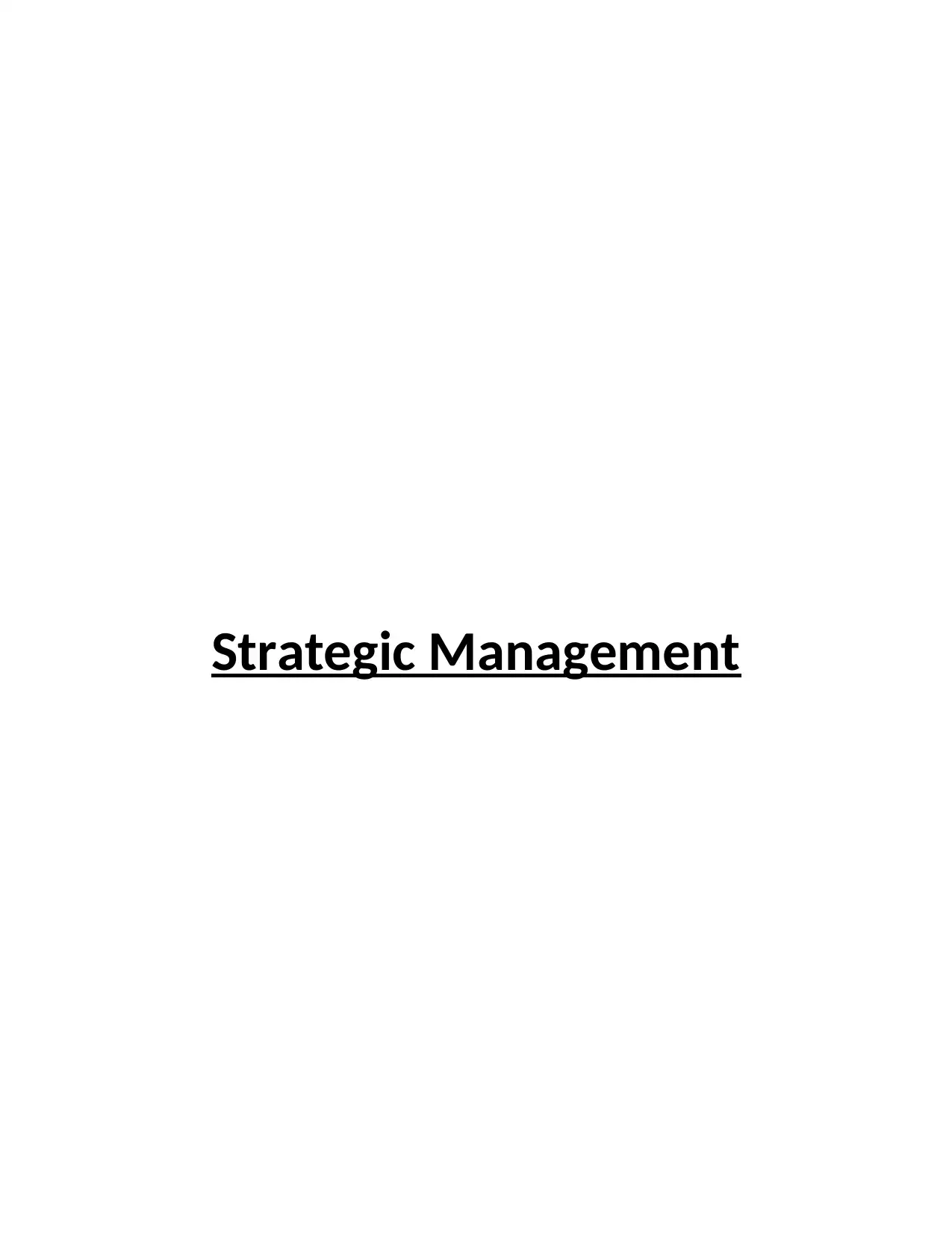
Strategic Management
Paraphrase This Document
Need a fresh take? Get an instant paraphrase of this document with our AI Paraphraser
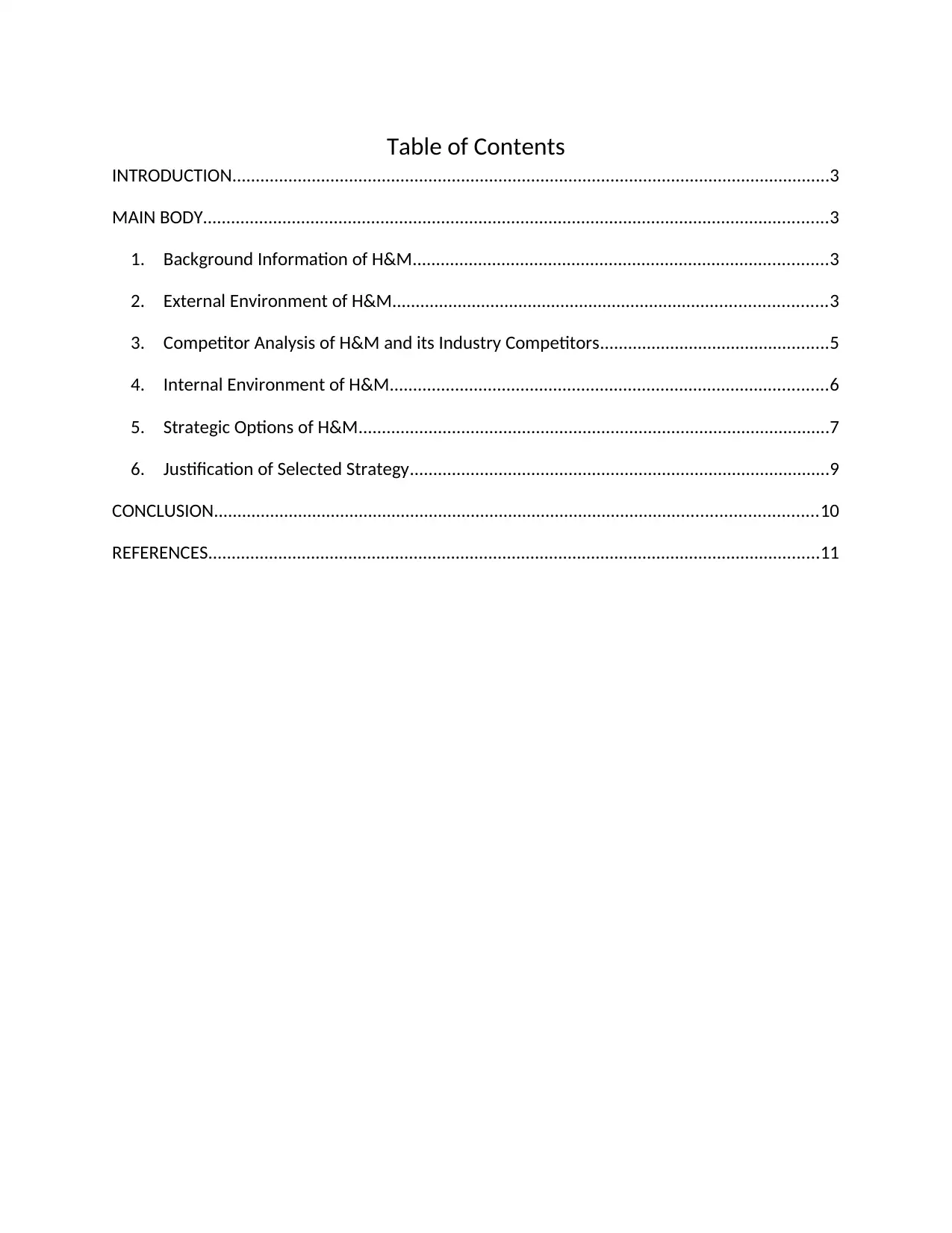
Table of Contents
INTRODUCTION................................................................................................................................3
MAIN BODY......................................................................................................................................3
1. Background Information of H&M.........................................................................................3
2. External Environment of H&M.............................................................................................3
3. Competitor Analysis of H&M and its Industry Competitors.................................................5
4. Internal Environment of H&M..............................................................................................6
5. Strategic Options of H&M.....................................................................................................7
6. Justification of Selected Strategy..........................................................................................9
CONCLUSION.................................................................................................................................10
REFERENCES...................................................................................................................................11
INTRODUCTION................................................................................................................................3
MAIN BODY......................................................................................................................................3
1. Background Information of H&M.........................................................................................3
2. External Environment of H&M.............................................................................................3
3. Competitor Analysis of H&M and its Industry Competitors.................................................5
4. Internal Environment of H&M..............................................................................................6
5. Strategic Options of H&M.....................................................................................................7
6. Justification of Selected Strategy..........................................................................................9
CONCLUSION.................................................................................................................................10
REFERENCES...................................................................................................................................11
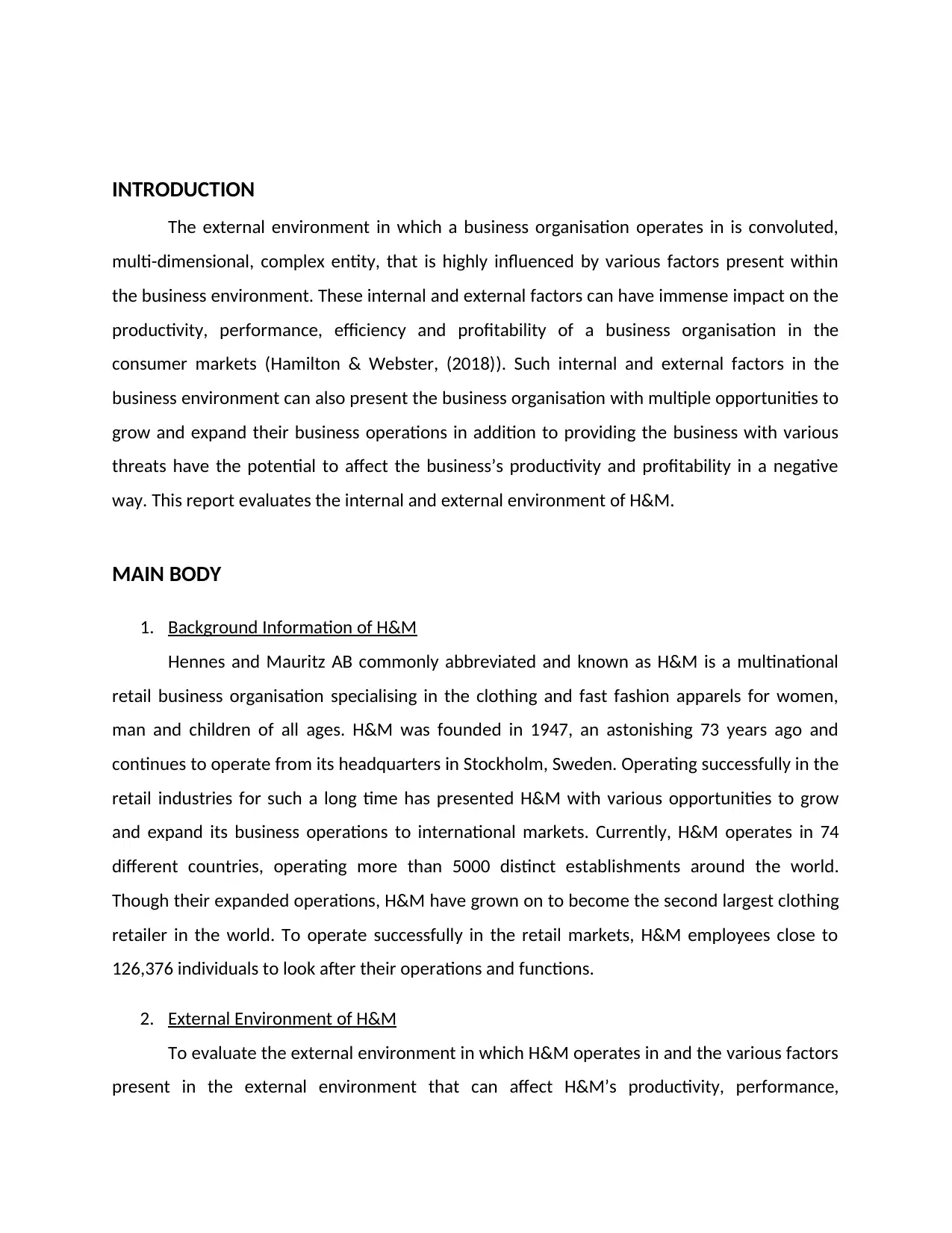
INTRODUCTION
The external environment in which a business organisation operates in is convoluted,
multi-dimensional, complex entity, that is highly influenced by various factors present within
the business environment. These internal and external factors can have immense impact on the
productivity, performance, efficiency and profitability of a business organisation in the
consumer markets (Hamilton & Webster, (2018)). Such internal and external factors in the
business environment can also present the business organisation with multiple opportunities to
grow and expand their business operations in addition to providing the business with various
threats have the potential to affect the business’s productivity and profitability in a negative
way. This report evaluates the internal and external environment of H&M.
MAIN BODY
1. Background Information of H&M
Hennes and Mauritz AB commonly abbreviated and known as H&M is a multinational
retail business organisation specialising in the clothing and fast fashion apparels for women,
man and children of all ages. H&M was founded in 1947, an astonishing 73 years ago and
continues to operate from its headquarters in Stockholm, Sweden. Operating successfully in the
retail industries for such a long time has presented H&M with various opportunities to grow
and expand its business operations to international markets. Currently, H&M operates in 74
different countries, operating more than 5000 distinct establishments around the world.
Though their expanded operations, H&M have grown on to become the second largest clothing
retailer in the world. To operate successfully in the retail markets, H&M employees close to
126,376 individuals to look after their operations and functions.
2. External Environment of H&M
To evaluate the external environment in which H&M operates in and the various factors
present in the external environment that can affect H&M’s productivity, performance,
The external environment in which a business organisation operates in is convoluted,
multi-dimensional, complex entity, that is highly influenced by various factors present within
the business environment. These internal and external factors can have immense impact on the
productivity, performance, efficiency and profitability of a business organisation in the
consumer markets (Hamilton & Webster, (2018)). Such internal and external factors in the
business environment can also present the business organisation with multiple opportunities to
grow and expand their business operations in addition to providing the business with various
threats have the potential to affect the business’s productivity and profitability in a negative
way. This report evaluates the internal and external environment of H&M.
MAIN BODY
1. Background Information of H&M
Hennes and Mauritz AB commonly abbreviated and known as H&M is a multinational
retail business organisation specialising in the clothing and fast fashion apparels for women,
man and children of all ages. H&M was founded in 1947, an astonishing 73 years ago and
continues to operate from its headquarters in Stockholm, Sweden. Operating successfully in the
retail industries for such a long time has presented H&M with various opportunities to grow
and expand its business operations to international markets. Currently, H&M operates in 74
different countries, operating more than 5000 distinct establishments around the world.
Though their expanded operations, H&M have grown on to become the second largest clothing
retailer in the world. To operate successfully in the retail markets, H&M employees close to
126,376 individuals to look after their operations and functions.
2. External Environment of H&M
To evaluate the external environment in which H&M operates in and the various factors
present in the external environment that can affect H&M’s productivity, performance,
⊘ This is a preview!⊘
Do you want full access?
Subscribe today to unlock all pages.

Trusted by 1+ million students worldwide
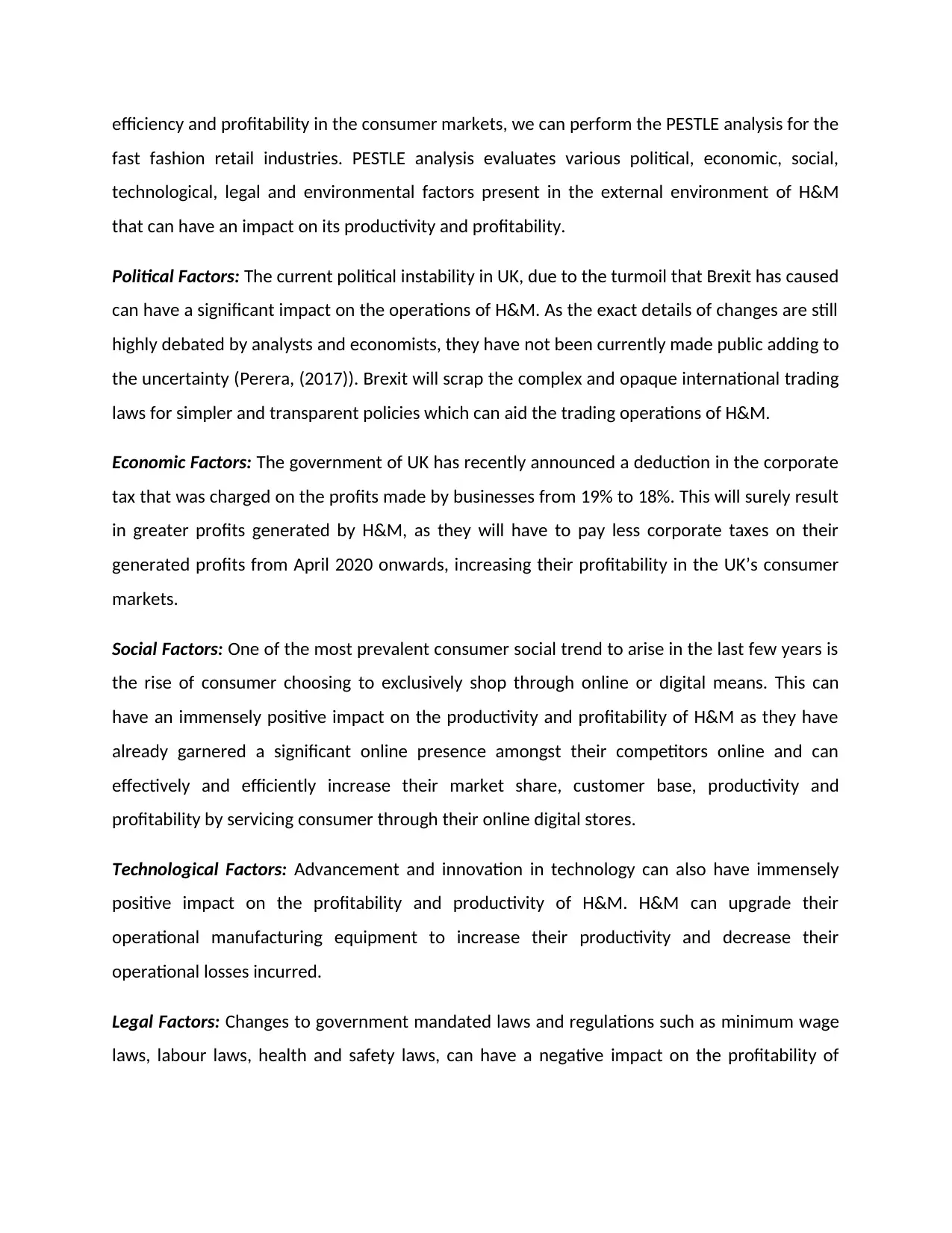
efficiency and profitability in the consumer markets, we can perform the PESTLE analysis for the
fast fashion retail industries. PESTLE analysis evaluates various political, economic, social,
technological, legal and environmental factors present in the external environment of H&M
that can have an impact on its productivity and profitability.
Political Factors: The current political instability in UK, due to the turmoil that Brexit has caused
can have a significant impact on the operations of H&M. As the exact details of changes are still
highly debated by analysts and economists, they have not been currently made public adding to
the uncertainty (Perera, (2017)). Brexit will scrap the complex and opaque international trading
laws for simpler and transparent policies which can aid the trading operations of H&M.
Economic Factors: The government of UK has recently announced a deduction in the corporate
tax that was charged on the profits made by businesses from 19% to 18%. This will surely result
in greater profits generated by H&M, as they will have to pay less corporate taxes on their
generated profits from April 2020 onwards, increasing their profitability in the UK’s consumer
markets.
Social Factors: One of the most prevalent consumer social trend to arise in the last few years is
the rise of consumer choosing to exclusively shop through online or digital means. This can
have an immensely positive impact on the productivity and profitability of H&M as they have
already garnered a significant online presence amongst their competitors online and can
effectively and efficiently increase their market share, customer base, productivity and
profitability by servicing consumer through their online digital stores.
Technological Factors: Advancement and innovation in technology can also have immensely
positive impact on the profitability and productivity of H&M. H&M can upgrade their
operational manufacturing equipment to increase their productivity and decrease their
operational losses incurred.
Legal Factors: Changes to government mandated laws and regulations such as minimum wage
laws, labour laws, health and safety laws, can have a negative impact on the profitability of
fast fashion retail industries. PESTLE analysis evaluates various political, economic, social,
technological, legal and environmental factors present in the external environment of H&M
that can have an impact on its productivity and profitability.
Political Factors: The current political instability in UK, due to the turmoil that Brexit has caused
can have a significant impact on the operations of H&M. As the exact details of changes are still
highly debated by analysts and economists, they have not been currently made public adding to
the uncertainty (Perera, (2017)). Brexit will scrap the complex and opaque international trading
laws for simpler and transparent policies which can aid the trading operations of H&M.
Economic Factors: The government of UK has recently announced a deduction in the corporate
tax that was charged on the profits made by businesses from 19% to 18%. This will surely result
in greater profits generated by H&M, as they will have to pay less corporate taxes on their
generated profits from April 2020 onwards, increasing their profitability in the UK’s consumer
markets.
Social Factors: One of the most prevalent consumer social trend to arise in the last few years is
the rise of consumer choosing to exclusively shop through online or digital means. This can
have an immensely positive impact on the productivity and profitability of H&M as they have
already garnered a significant online presence amongst their competitors online and can
effectively and efficiently increase their market share, customer base, productivity and
profitability by servicing consumer through their online digital stores.
Technological Factors: Advancement and innovation in technology can also have immensely
positive impact on the profitability and productivity of H&M. H&M can upgrade their
operational manufacturing equipment to increase their productivity and decrease their
operational losses incurred.
Legal Factors: Changes to government mandated laws and regulations such as minimum wage
laws, labour laws, health and safety laws, can have a negative impact on the profitability of
Paraphrase This Document
Need a fresh take? Get an instant paraphrase of this document with our AI Paraphraser
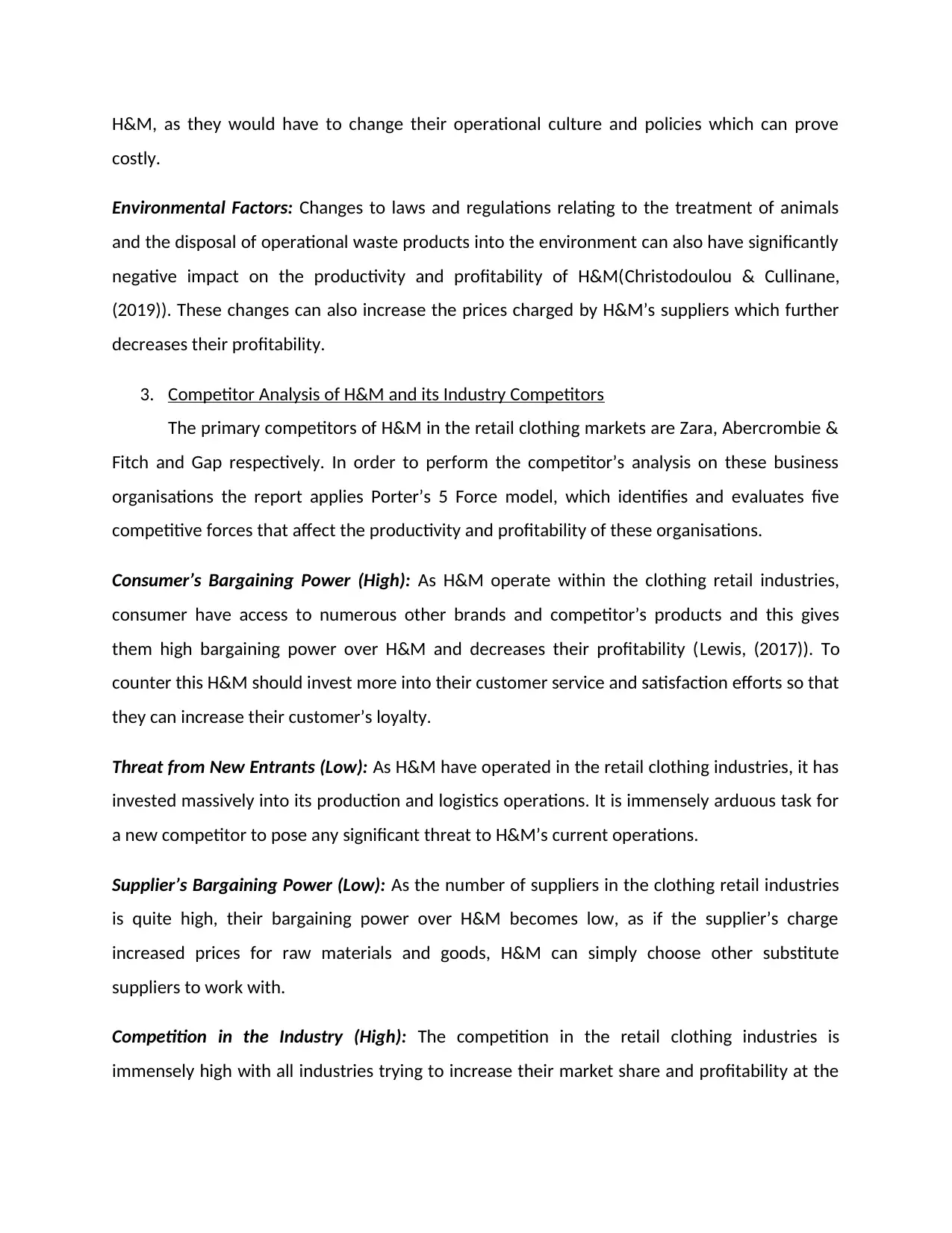
H&M, as they would have to change their operational culture and policies which can prove
costly.
Environmental Factors: Changes to laws and regulations relating to the treatment of animals
and the disposal of operational waste products into the environment can also have significantly
negative impact on the productivity and profitability of H&M(Christodoulou & Cullinane,
(2019)). These changes can also increase the prices charged by H&M’s suppliers which further
decreases their profitability.
3. Competitor Analysis of H&M and its Industry Competitors
The primary competitors of H&M in the retail clothing markets are Zara, Abercrombie &
Fitch and Gap respectively. In order to perform the competitor’s analysis on these business
organisations the report applies Porter’s 5 Force model, which identifies and evaluates five
competitive forces that affect the productivity and profitability of these organisations.
Consumer’s Bargaining Power (High): As H&M operate within the clothing retail industries,
consumer have access to numerous other brands and competitor’s products and this gives
them high bargaining power over H&M and decreases their profitability (Lewis, (2017)). To
counter this H&M should invest more into their customer service and satisfaction efforts so that
they can increase their customer’s loyalty.
Threat from New Entrants (Low): As H&M have operated in the retail clothing industries, it has
invested massively into its production and logistics operations. It is immensely arduous task for
a new competitor to pose any significant threat to H&M’s current operations.
Supplier’s Bargaining Power (Low): As the number of suppliers in the clothing retail industries
is quite high, their bargaining power over H&M becomes low, as if the supplier’s charge
increased prices for raw materials and goods, H&M can simply choose other substitute
suppliers to work with.
Competition in the Industry (High): The competition in the retail clothing industries is
immensely high with all industries trying to increase their market share and profitability at the
costly.
Environmental Factors: Changes to laws and regulations relating to the treatment of animals
and the disposal of operational waste products into the environment can also have significantly
negative impact on the productivity and profitability of H&M(Christodoulou & Cullinane,
(2019)). These changes can also increase the prices charged by H&M’s suppliers which further
decreases their profitability.
3. Competitor Analysis of H&M and its Industry Competitors
The primary competitors of H&M in the retail clothing markets are Zara, Abercrombie &
Fitch and Gap respectively. In order to perform the competitor’s analysis on these business
organisations the report applies Porter’s 5 Force model, which identifies and evaluates five
competitive forces that affect the productivity and profitability of these organisations.
Consumer’s Bargaining Power (High): As H&M operate within the clothing retail industries,
consumer have access to numerous other brands and competitor’s products and this gives
them high bargaining power over H&M and decreases their profitability (Lewis, (2017)). To
counter this H&M should invest more into their customer service and satisfaction efforts so that
they can increase their customer’s loyalty.
Threat from New Entrants (Low): As H&M have operated in the retail clothing industries, it has
invested massively into its production and logistics operations. It is immensely arduous task for
a new competitor to pose any significant threat to H&M’s current operations.
Supplier’s Bargaining Power (Low): As the number of suppliers in the clothing retail industries
is quite high, their bargaining power over H&M becomes low, as if the supplier’s charge
increased prices for raw materials and goods, H&M can simply choose other substitute
suppliers to work with.
Competition in the Industry (High): The competition in the retail clothing industries is
immensely high with all industries trying to increase their market share and profitability at the
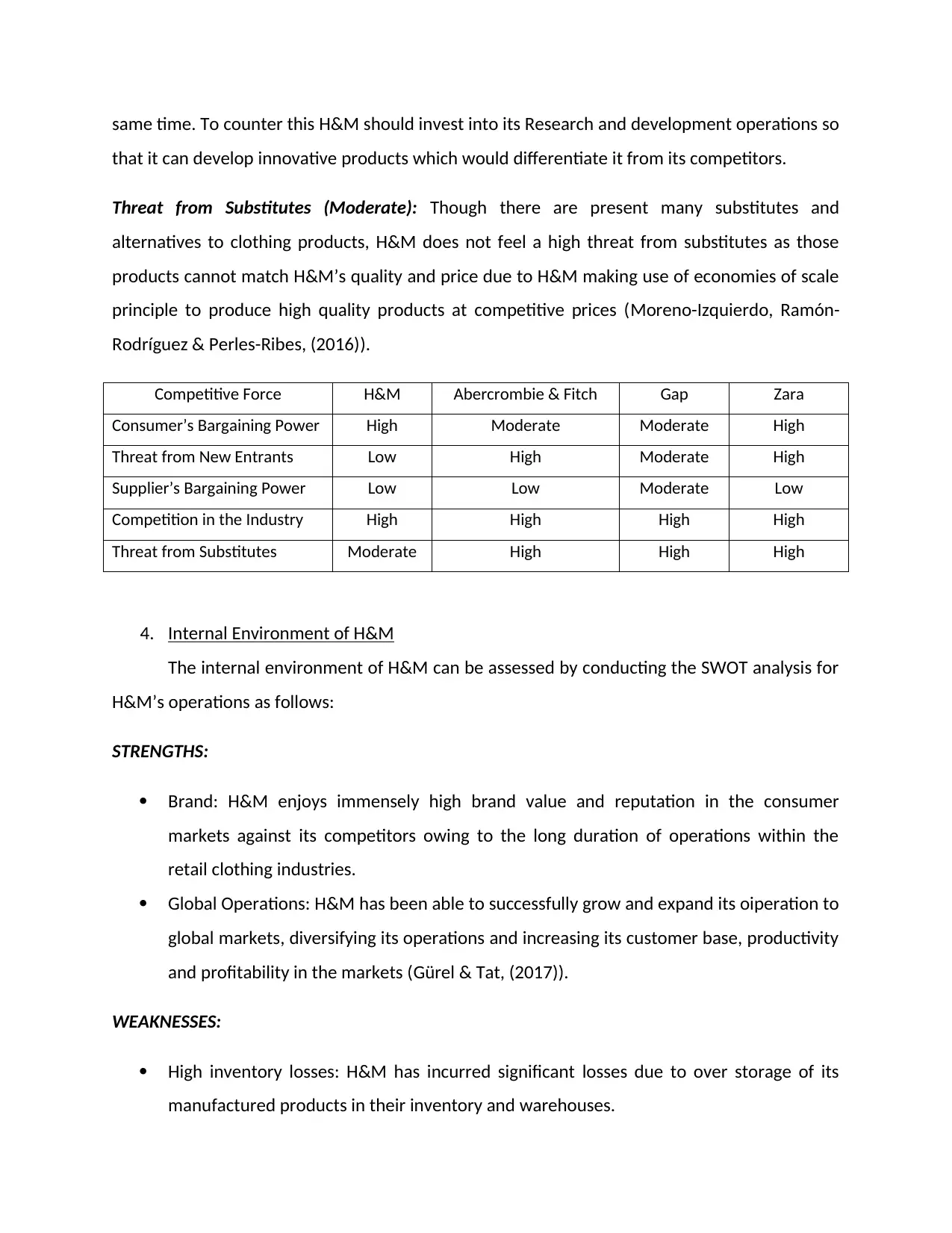
same time. To counter this H&M should invest into its Research and development operations so
that it can develop innovative products which would differentiate it from its competitors.
Threat from Substitutes (Moderate): Though there are present many substitutes and
alternatives to clothing products, H&M does not feel a high threat from substitutes as those
products cannot match H&M’s quality and price due to H&M making use of economies of scale
principle to produce high quality products at competitive prices (Moreno-Izquierdo, Ramón-
Rodríguez & Perles-Ribes, (2016)).
Competitive Force H&M Abercrombie & Fitch Gap Zara
Consumer’s Bargaining Power High Moderate Moderate High
Threat from New Entrants Low High Moderate High
Supplier’s Bargaining Power Low Low Moderate Low
Competition in the Industry High High High High
Threat from Substitutes Moderate High High High
4. Internal Environment of H&M
The internal environment of H&M can be assessed by conducting the SWOT analysis for
H&M’s operations as follows:
STRENGTHS:
Brand: H&M enjoys immensely high brand value and reputation in the consumer
markets against its competitors owing to the long duration of operations within the
retail clothing industries.
Global Operations: H&M has been able to successfully grow and expand its oiperation to
global markets, diversifying its operations and increasing its customer base, productivity
and profitability in the markets (Gürel & Tat, (2017)).
WEAKNESSES:
High inventory losses: H&M has incurred significant losses due to over storage of its
manufactured products in their inventory and warehouses.
that it can develop innovative products which would differentiate it from its competitors.
Threat from Substitutes (Moderate): Though there are present many substitutes and
alternatives to clothing products, H&M does not feel a high threat from substitutes as those
products cannot match H&M’s quality and price due to H&M making use of economies of scale
principle to produce high quality products at competitive prices (Moreno-Izquierdo, Ramón-
Rodríguez & Perles-Ribes, (2016)).
Competitive Force H&M Abercrombie & Fitch Gap Zara
Consumer’s Bargaining Power High Moderate Moderate High
Threat from New Entrants Low High Moderate High
Supplier’s Bargaining Power Low Low Moderate Low
Competition in the Industry High High High High
Threat from Substitutes Moderate High High High
4. Internal Environment of H&M
The internal environment of H&M can be assessed by conducting the SWOT analysis for
H&M’s operations as follows:
STRENGTHS:
Brand: H&M enjoys immensely high brand value and reputation in the consumer
markets against its competitors owing to the long duration of operations within the
retail clothing industries.
Global Operations: H&M has been able to successfully grow and expand its oiperation to
global markets, diversifying its operations and increasing its customer base, productivity
and profitability in the markets (Gürel & Tat, (2017)).
WEAKNESSES:
High inventory losses: H&M has incurred significant losses due to over storage of its
manufactured products in their inventory and warehouses.
⊘ This is a preview!⊘
Do you want full access?
Subscribe today to unlock all pages.

Trusted by 1+ million students worldwide
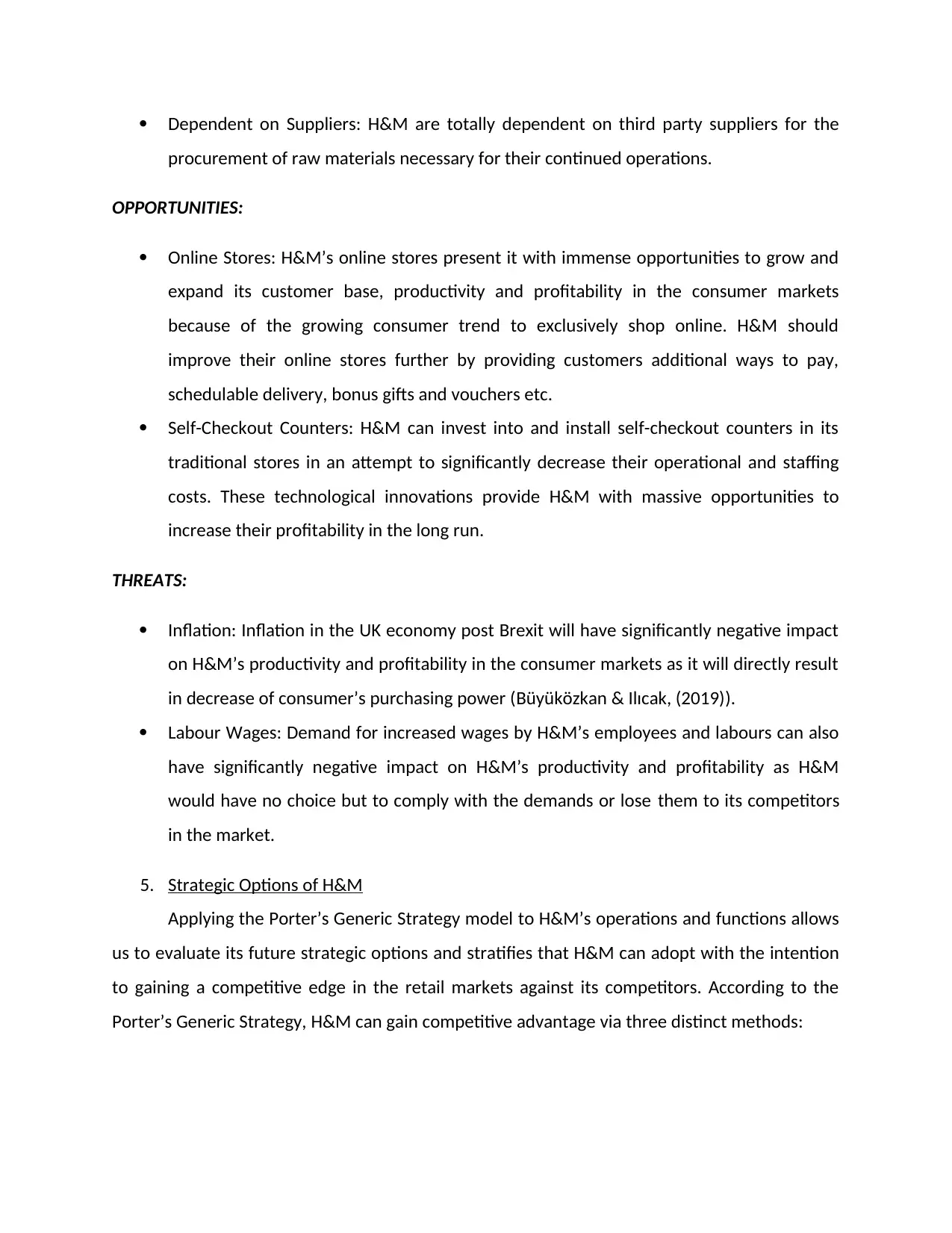
Dependent on Suppliers: H&M are totally dependent on third party suppliers for the
procurement of raw materials necessary for their continued operations.
OPPORTUNITIES:
Online Stores: H&M’s online stores present it with immense opportunities to grow and
expand its customer base, productivity and profitability in the consumer markets
because of the growing consumer trend to exclusively shop online. H&M should
improve their online stores further by providing customers additional ways to pay,
schedulable delivery, bonus gifts and vouchers etc.
Self-Checkout Counters: H&M can invest into and install self-checkout counters in its
traditional stores in an attempt to significantly decrease their operational and staffing
costs. These technological innovations provide H&M with massive opportunities to
increase their profitability in the long run.
THREATS:
Inflation: Inflation in the UK economy post Brexit will have significantly negative impact
on H&M’s productivity and profitability in the consumer markets as it will directly result
in decrease of consumer’s purchasing power (Büyüközkan & Ilıcak, (2019)).
Labour Wages: Demand for increased wages by H&M’s employees and labours can also
have significantly negative impact on H&M’s productivity and profitability as H&M
would have no choice but to comply with the demands or lose them to its competitors
in the market.
5. Strategic Options of H&M
Applying the Porter’s Generic Strategy model to H&M’s operations and functions allows
us to evaluate its future strategic options and stratifies that H&M can adopt with the intention
to gaining a competitive edge in the retail markets against its competitors. According to the
Porter’s Generic Strategy, H&M can gain competitive advantage via three distinct methods:
procurement of raw materials necessary for their continued operations.
OPPORTUNITIES:
Online Stores: H&M’s online stores present it with immense opportunities to grow and
expand its customer base, productivity and profitability in the consumer markets
because of the growing consumer trend to exclusively shop online. H&M should
improve their online stores further by providing customers additional ways to pay,
schedulable delivery, bonus gifts and vouchers etc.
Self-Checkout Counters: H&M can invest into and install self-checkout counters in its
traditional stores in an attempt to significantly decrease their operational and staffing
costs. These technological innovations provide H&M with massive opportunities to
increase their profitability in the long run.
THREATS:
Inflation: Inflation in the UK economy post Brexit will have significantly negative impact
on H&M’s productivity and profitability in the consumer markets as it will directly result
in decrease of consumer’s purchasing power (Büyüközkan & Ilıcak, (2019)).
Labour Wages: Demand for increased wages by H&M’s employees and labours can also
have significantly negative impact on H&M’s productivity and profitability as H&M
would have no choice but to comply with the demands or lose them to its competitors
in the market.
5. Strategic Options of H&M
Applying the Porter’s Generic Strategy model to H&M’s operations and functions allows
us to evaluate its future strategic options and stratifies that H&M can adopt with the intention
to gaining a competitive edge in the retail markets against its competitors. According to the
Porter’s Generic Strategy, H&M can gain competitive advantage via three distinct methods:
Paraphrase This Document
Need a fresh take? Get an instant paraphrase of this document with our AI Paraphraser
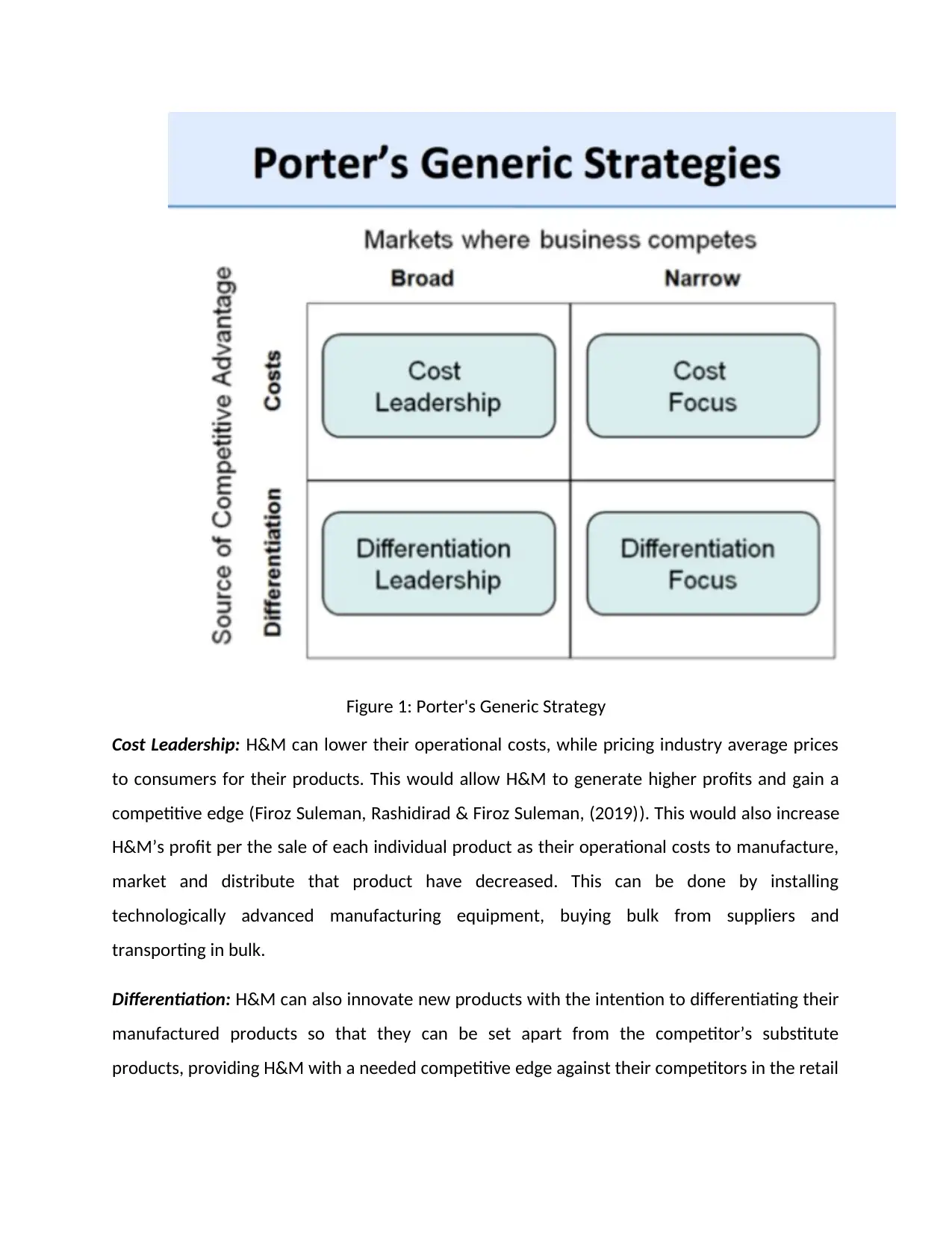
Figure 1: Porter's Generic Strategy
Cost Leadership: H&M can lower their operational costs, while pricing industry average prices
to consumers for their products. This would allow H&M to generate higher profits and gain a
competitive edge (Firoz Suleman, Rashidirad & Firoz Suleman, (2019)). This would also increase
H&M’s profit per the sale of each individual product as their operational costs to manufacture,
market and distribute that product have decreased. This can be done by installing
technologically advanced manufacturing equipment, buying bulk from suppliers and
transporting in bulk.
Differentiation: H&M can also innovate new products with the intention to differentiating their
manufactured products so that they can be set apart from the competitor’s substitute
products, providing H&M with a needed competitive edge against their competitors in the retail
Cost Leadership: H&M can lower their operational costs, while pricing industry average prices
to consumers for their products. This would allow H&M to generate higher profits and gain a
competitive edge (Firoz Suleman, Rashidirad & Firoz Suleman, (2019)). This would also increase
H&M’s profit per the sale of each individual product as their operational costs to manufacture,
market and distribute that product have decreased. This can be done by installing
technologically advanced manufacturing equipment, buying bulk from suppliers and
transporting in bulk.
Differentiation: H&M can also innovate new products with the intention to differentiating their
manufactured products so that they can be set apart from the competitor’s substitute
products, providing H&M with a needed competitive edge against their competitors in the retail
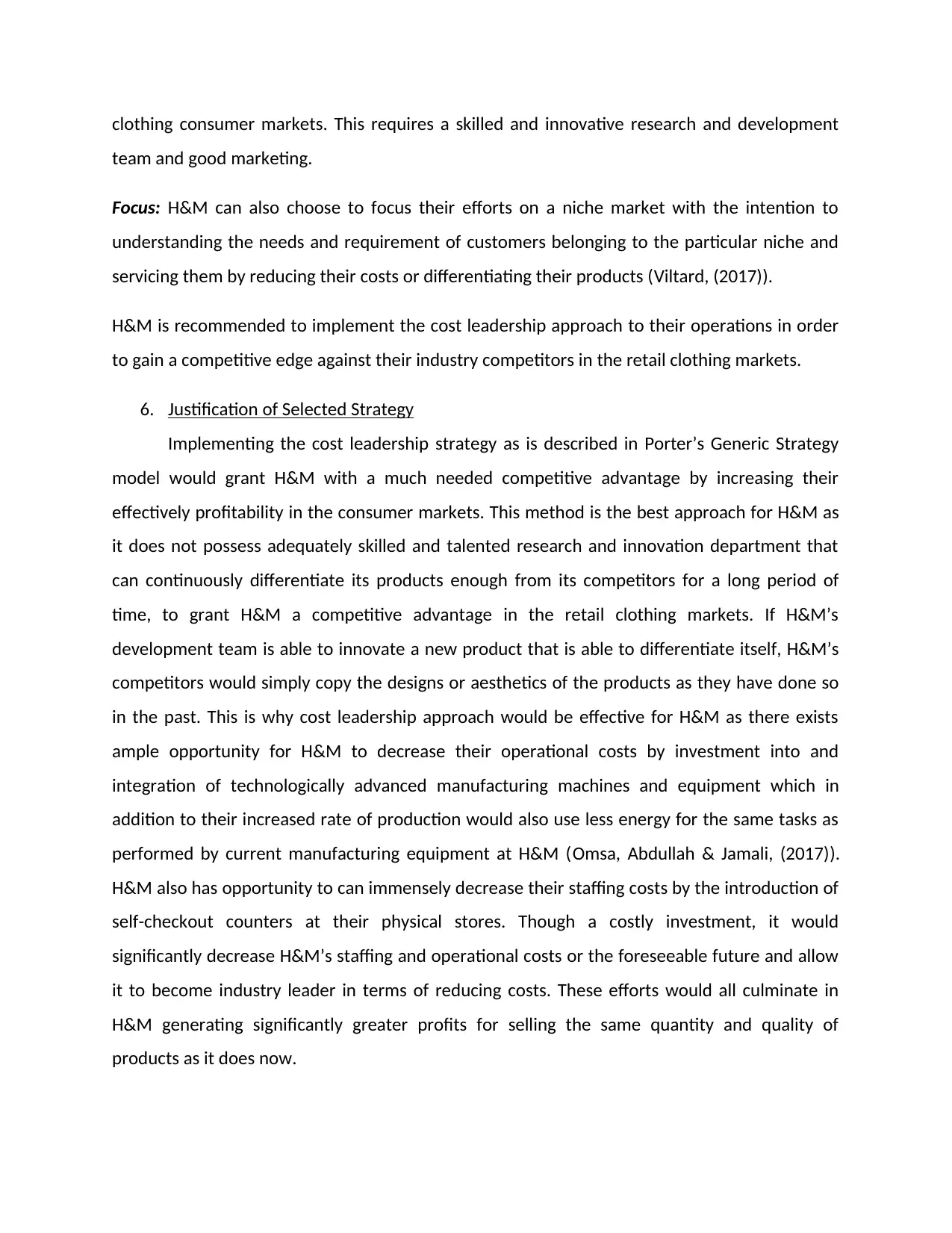
clothing consumer markets. This requires a skilled and innovative research and development
team and good marketing.
Focus: H&M can also choose to focus their efforts on a niche market with the intention to
understanding the needs and requirement of customers belonging to the particular niche and
servicing them by reducing their costs or differentiating their products (Viltard, (2017)).
H&M is recommended to implement the cost leadership approach to their operations in order
to gain a competitive edge against their industry competitors in the retail clothing markets.
6. Justification of Selected Strategy
Implementing the cost leadership strategy as is described in Porter’s Generic Strategy
model would grant H&M with a much needed competitive advantage by increasing their
effectively profitability in the consumer markets. This method is the best approach for H&M as
it does not possess adequately skilled and talented research and innovation department that
can continuously differentiate its products enough from its competitors for a long period of
time, to grant H&M a competitive advantage in the retail clothing markets. If H&M’s
development team is able to innovate a new product that is able to differentiate itself, H&M’s
competitors would simply copy the designs or aesthetics of the products as they have done so
in the past. This is why cost leadership approach would be effective for H&M as there exists
ample opportunity for H&M to decrease their operational costs by investment into and
integration of technologically advanced manufacturing machines and equipment which in
addition to their increased rate of production would also use less energy for the same tasks as
performed by current manufacturing equipment at H&M (Omsa, Abdullah & Jamali, (2017)).
H&M also has opportunity to can immensely decrease their staffing costs by the introduction of
self-checkout counters at their physical stores. Though a costly investment, it would
significantly decrease H&M’s staffing and operational costs or the foreseeable future and allow
it to become industry leader in terms of reducing costs. These efforts would all culminate in
H&M generating significantly greater profits for selling the same quantity and quality of
products as it does now.
team and good marketing.
Focus: H&M can also choose to focus their efforts on a niche market with the intention to
understanding the needs and requirement of customers belonging to the particular niche and
servicing them by reducing their costs or differentiating their products (Viltard, (2017)).
H&M is recommended to implement the cost leadership approach to their operations in order
to gain a competitive edge against their industry competitors in the retail clothing markets.
6. Justification of Selected Strategy
Implementing the cost leadership strategy as is described in Porter’s Generic Strategy
model would grant H&M with a much needed competitive advantage by increasing their
effectively profitability in the consumer markets. This method is the best approach for H&M as
it does not possess adequately skilled and talented research and innovation department that
can continuously differentiate its products enough from its competitors for a long period of
time, to grant H&M a competitive advantage in the retail clothing markets. If H&M’s
development team is able to innovate a new product that is able to differentiate itself, H&M’s
competitors would simply copy the designs or aesthetics of the products as they have done so
in the past. This is why cost leadership approach would be effective for H&M as there exists
ample opportunity for H&M to decrease their operational costs by investment into and
integration of technologically advanced manufacturing machines and equipment which in
addition to their increased rate of production would also use less energy for the same tasks as
performed by current manufacturing equipment at H&M (Omsa, Abdullah & Jamali, (2017)).
H&M also has opportunity to can immensely decrease their staffing costs by the introduction of
self-checkout counters at their physical stores. Though a costly investment, it would
significantly decrease H&M’s staffing and operational costs or the foreseeable future and allow
it to become industry leader in terms of reducing costs. These efforts would all culminate in
H&M generating significantly greater profits for selling the same quantity and quality of
products as it does now.
⊘ This is a preview!⊘
Do you want full access?
Subscribe today to unlock all pages.

Trusted by 1+ million students worldwide
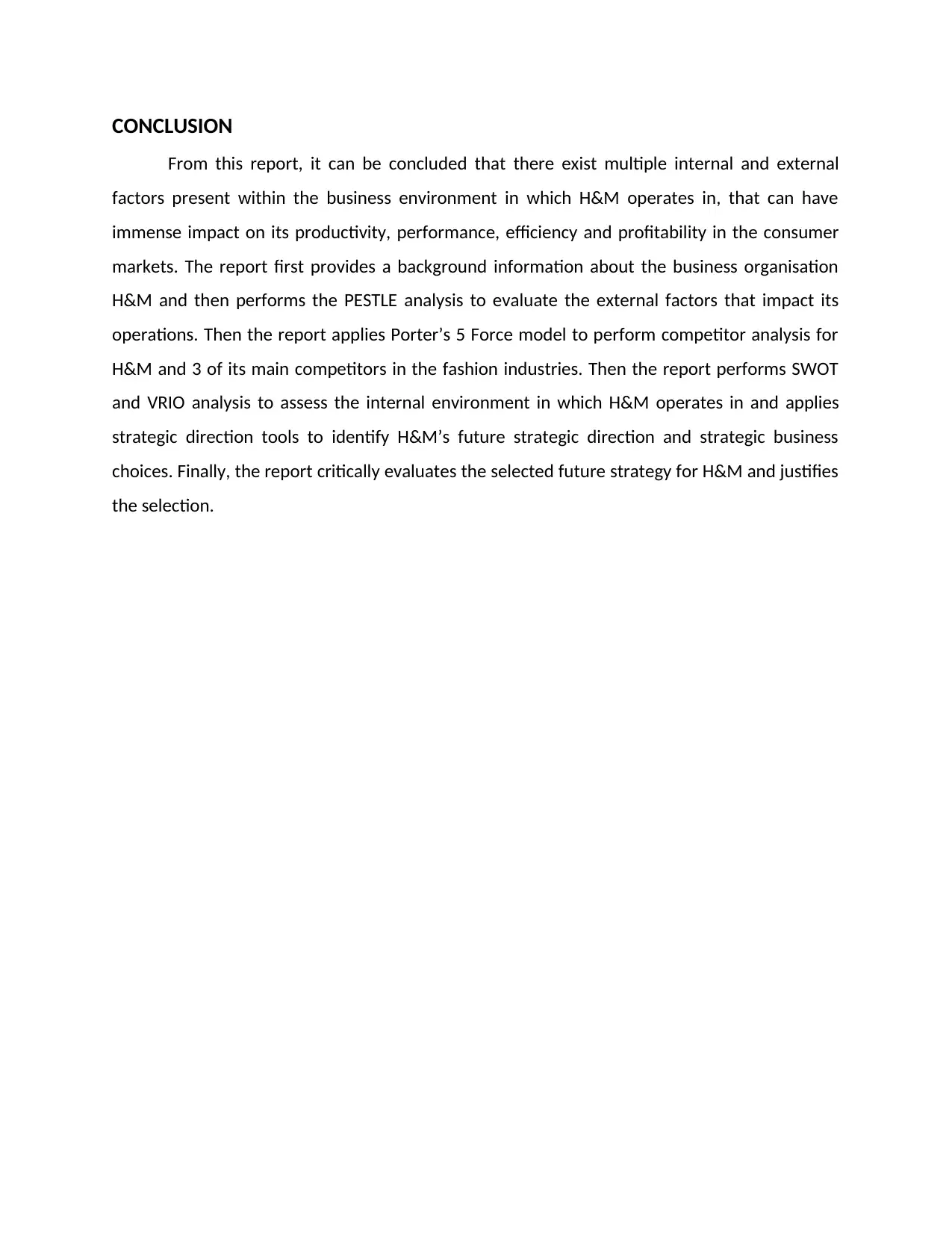
CONCLUSION
From this report, it can be concluded that there exist multiple internal and external
factors present within the business environment in which H&M operates in, that can have
immense impact on its productivity, performance, efficiency and profitability in the consumer
markets. The report first provides a background information about the business organisation
H&M and then performs the PESTLE analysis to evaluate the external factors that impact its
operations. Then the report applies Porter’s 5 Force model to perform competitor analysis for
H&M and 3 of its main competitors in the fashion industries. Then the report performs SWOT
and VRIO analysis to assess the internal environment in which H&M operates in and applies
strategic direction tools to identify H&M’s future strategic direction and strategic business
choices. Finally, the report critically evaluates the selected future strategy for H&M and justifies
the selection.
From this report, it can be concluded that there exist multiple internal and external
factors present within the business environment in which H&M operates in, that can have
immense impact on its productivity, performance, efficiency and profitability in the consumer
markets. The report first provides a background information about the business organisation
H&M and then performs the PESTLE analysis to evaluate the external factors that impact its
operations. Then the report applies Porter’s 5 Force model to perform competitor analysis for
H&M and 3 of its main competitors in the fashion industries. Then the report performs SWOT
and VRIO analysis to assess the internal environment in which H&M operates in and applies
strategic direction tools to identify H&M’s future strategic direction and strategic business
choices. Finally, the report critically evaluates the selected future strategy for H&M and justifies
the selection.
Paraphrase This Document
Need a fresh take? Get an instant paraphrase of this document with our AI Paraphraser
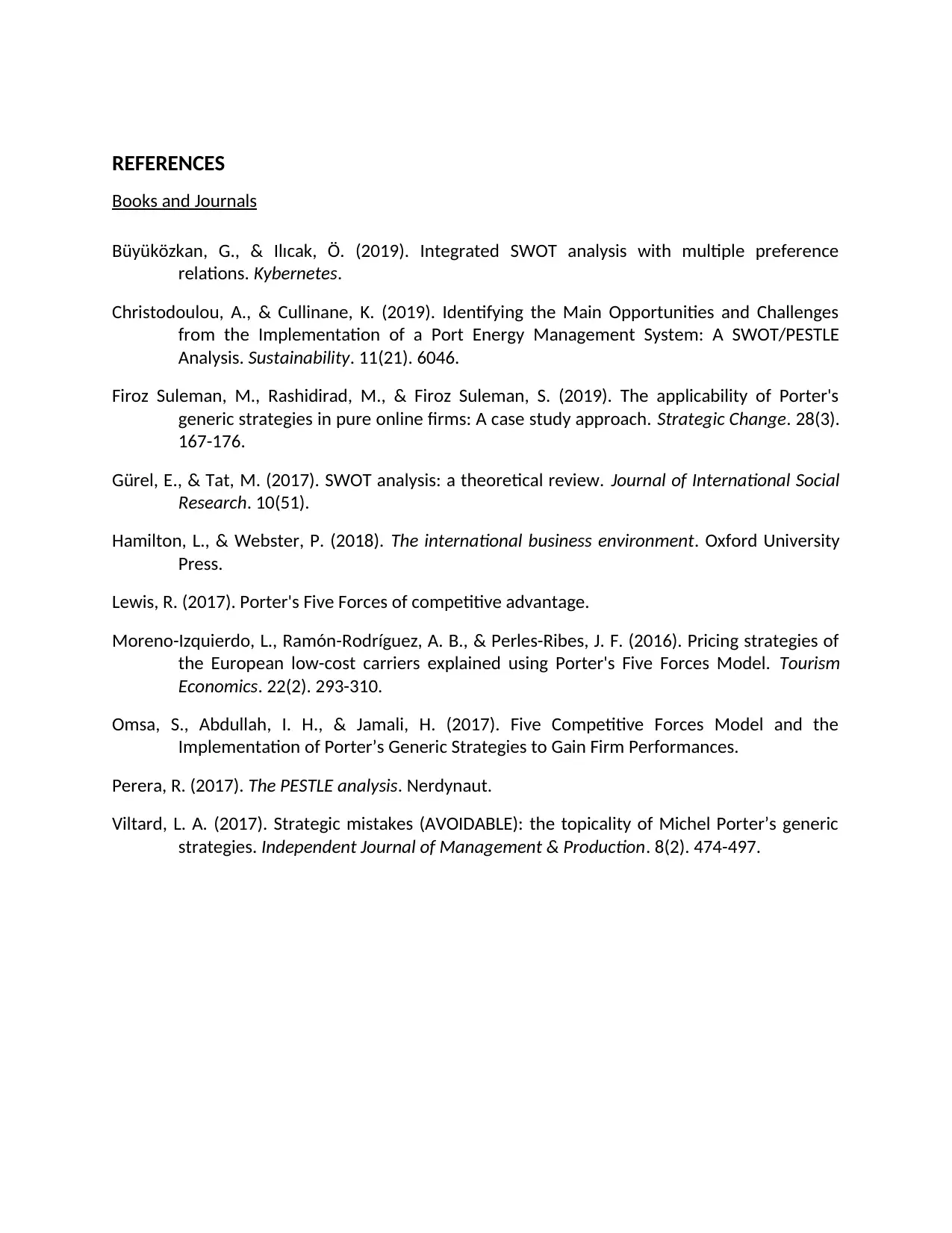
REFERENCES
Books and Journals
Büyüközkan, G., & Ilıcak, Ö. (2019). Integrated SWOT analysis with multiple preference
relations. Kybernetes.
Christodoulou, A., & Cullinane, K. (2019). Identifying the Main Opportunities and Challenges
from the Implementation of a Port Energy Management System: A SWOT/PESTLE
Analysis. Sustainability. 11(21). 6046.
Firoz Suleman, M., Rashidirad, M., & Firoz Suleman, S. (2019). The applicability of Porter's
generic strategies in pure online firms: A case study approach. Strategic Change. 28(3).
167-176.
Gürel, E., & Tat, M. (2017). SWOT analysis: a theoretical review. Journal of International Social
Research. 10(51).
Hamilton, L., & Webster, P. (2018). The international business environment. Oxford University
Press.
Lewis, R. (2017). Porter's Five Forces of competitive advantage.
Moreno-Izquierdo, L., Ramón-Rodríguez, A. B., & Perles-Ribes, J. F. (2016). Pricing strategies of
the European low-cost carriers explained using Porter's Five Forces Model. Tourism
Economics. 22(2). 293-310.
Omsa, S., Abdullah, I. H., & Jamali, H. (2017). Five Competitive Forces Model and the
Implementation of Porter’s Generic Strategies to Gain Firm Performances.
Perera, R. (2017). The PESTLE analysis. Nerdynaut.
Viltard, L. A. (2017). Strategic mistakes (AVOIDABLE): the topicality of Michel Porter’s generic
strategies. Independent Journal of Management & Production. 8(2). 474-497.
Books and Journals
Büyüközkan, G., & Ilıcak, Ö. (2019). Integrated SWOT analysis with multiple preference
relations. Kybernetes.
Christodoulou, A., & Cullinane, K. (2019). Identifying the Main Opportunities and Challenges
from the Implementation of a Port Energy Management System: A SWOT/PESTLE
Analysis. Sustainability. 11(21). 6046.
Firoz Suleman, M., Rashidirad, M., & Firoz Suleman, S. (2019). The applicability of Porter's
generic strategies in pure online firms: A case study approach. Strategic Change. 28(3).
167-176.
Gürel, E., & Tat, M. (2017). SWOT analysis: a theoretical review. Journal of International Social
Research. 10(51).
Hamilton, L., & Webster, P. (2018). The international business environment. Oxford University
Press.
Lewis, R. (2017). Porter's Five Forces of competitive advantage.
Moreno-Izquierdo, L., Ramón-Rodríguez, A. B., & Perles-Ribes, J. F. (2016). Pricing strategies of
the European low-cost carriers explained using Porter's Five Forces Model. Tourism
Economics. 22(2). 293-310.
Omsa, S., Abdullah, I. H., & Jamali, H. (2017). Five Competitive Forces Model and the
Implementation of Porter’s Generic Strategies to Gain Firm Performances.
Perera, R. (2017). The PESTLE analysis. Nerdynaut.
Viltard, L. A. (2017). Strategic mistakes (AVOIDABLE): the topicality of Michel Porter’s generic
strategies. Independent Journal of Management & Production. 8(2). 474-497.

⊘ This is a preview!⊘
Do you want full access?
Subscribe today to unlock all pages.

Trusted by 1+ million students worldwide
1 out of 12
Related Documents
Your All-in-One AI-Powered Toolkit for Academic Success.
+13062052269
info@desklib.com
Available 24*7 on WhatsApp / Email
![[object Object]](/_next/static/media/star-bottom.7253800d.svg)
Unlock your academic potential
Copyright © 2020–2025 A2Z Services. All Rights Reserved. Developed and managed by ZUCOL.





